A gamebook: you can read it and play it.
Whenever I go to a thrift store or find a Little Free Library, I am on the prowl for playful, gamey fiction. While I haven’t found much, I have uncovered some surprisingly nice titles.
Alright, to be honest, a couple of the titles below are less Choose Your Own Adventure and more like I Spy, or regular books with a high score. But these are so hard to categorize, so just for convenience, I’m using “gamebook” here as a catch-all term.
Also, before we start the article: don’t get the impression that no new gamebooks are being published. They are; I’ve seen them on the shelf. I’m just too stingy to buy most of the new ones! Let’s begin.
1. Choose Your Own Adventure: Horror House by Edward Packard
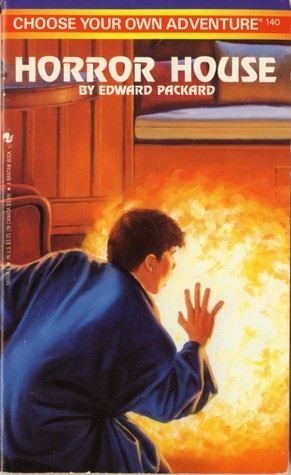
This is the first Choose Your Own Adventure-brand book I’ve actually really sincerely liked.
To understand why, I’ve gotta tell you what I love most in gamebooks: convincing paths. What do I mean by this? Well, here are my EXTREMELY SUBJECTIVE AND PERSONAL preferences for the CYOAs I pick up:
- At least one branch of every fork should feel like something I might actually do. This is based on my first, formative, primal CYOA memory. In my local library, my younger self found You Are a Millionaire, which asked the question, “What would YOU do if you were a millionaire?” Well, it starts with a kid finding that million dollars left alone in a bush. I decide that I would return the money. The story ended one page later. I closed the book thinking, “Well, that was awful.” And why would I ever choose any other option? It said it was about what I would really do!
Now I’m intrepid enough that I like trying alternate paths, but I guess I was literal-minded, as well as stubbornly committed to the book’s selling point. I like it when gamebooks can keep up the illusion that you’re not just a reader, you’re a participant moving through a world. - No instant deaths! Well, that’s a bit extreme. Instant deaths can be vital. and it’s hard to totally avoid them without merely extending blatant, boring dead ends. For example, let’s say your character is a knight on a rope bridge. Wood’s breaking underneath you. If you stay, you fall…and if the story then forces your character to writhe at the bottom of the pit and make three more false, useless decisions, it’s really just wasting your time. But if your character lands in a dungeon, I love it if there’s a chance you can escape. (That example is taken from Robin of Sherwood: The Sword of the Templar.)
- No truly random decisions! Well, that’s extreme too. Randomness can be fun (Fabled Lands book 3…if you know, you know), but I hate, hate, hate it when a book seems to be full of it. Beyond the Galaxy, the fourth-ever CYOA book, has so much randomness that it made me apathetic. It was so random that I never felt I could make an informed decision; I would simply go off to a wacky planet, or fly unexpectedly into a wacky black hole, and discover that an unexpected solution can pull me out again. Eventually I felt like a reader rather than a participant—for most books this is fine, but for gamebooks (for me), that’s the kiss of death.
- Ideally, a few forks should present real dilemmas that I have to stop and think about. A decision where each choice is good in its own way, or, better yet, with pros and cons on either end. “Should I befriend this person who has information I could use, or do I think they might double-cross me?” Stuff like that. A very effective one can get me to feel real suspense and nervousness about the results, which sounds ridiculous but is true.
As mentioned in that list above, my first two CYOAs did not inspire me whatsoever. Yet I would create gamebooks of my own (though I didn’t know to call them that) and interactive quizzes, becoming a lifelong fan of CYOA-style fiction when I rediscovered it online.
I wanted to love books like this, but never had. Now I have the chance to analyze Horror House and see what makes it different.
In Horror House, you play an ordinary boy…except your aunt is living in a haunted house. Strange sounds, flocks of crows, and the constant suspicion of your neighbors plague the place. It’s up to you to solve the mystery! Or convince her to sell the house. You can do that too.
If that last part doesn’t sound like a compelling ending, oho, let me try to convince you that it kind of is. You can end the game with your whole family perfectly fine and the house sold or even simply ignored, but on that final page, your character will always wonder about that house and what could still be lingering within. Some endings will even give you a hint about that mystery, including things you couldn’t learn in the “best ending” alone. For instance, a neighbor might let something interesting slip, or you might see a suspicious figure outside…
The effect is both to tantalize the reader and to encourage them to try again, with a good chance you’ll take even more of the “useless” roads less traveled. Once you hit the main ending with a few of these other paths under your belt, that conclusion is also more satisfying thanks to your journey. You could almost call it cumulative. It’s not that you’re getting hints about what to do next; you’re simply learning bits and pieces about the world which, hopefully, get you more invested in the people and world, and more curious about what’s left to discover.
Yeah, some of these choices are definitely not informed decisions, but again, they tantalize and build out the world. Plus, a couple are genuinely funny.
I’d definitely recommend this. Unfortunately, I think it’s out of print, with my crusty library-stickered 90s edition potentially being the only release. That feels odd for a series as often-reprinted as Choose Your Own Adventure. I must be wrong, right?
2. Pick Your Path Scream Shop: Abracadanger by Tracey West
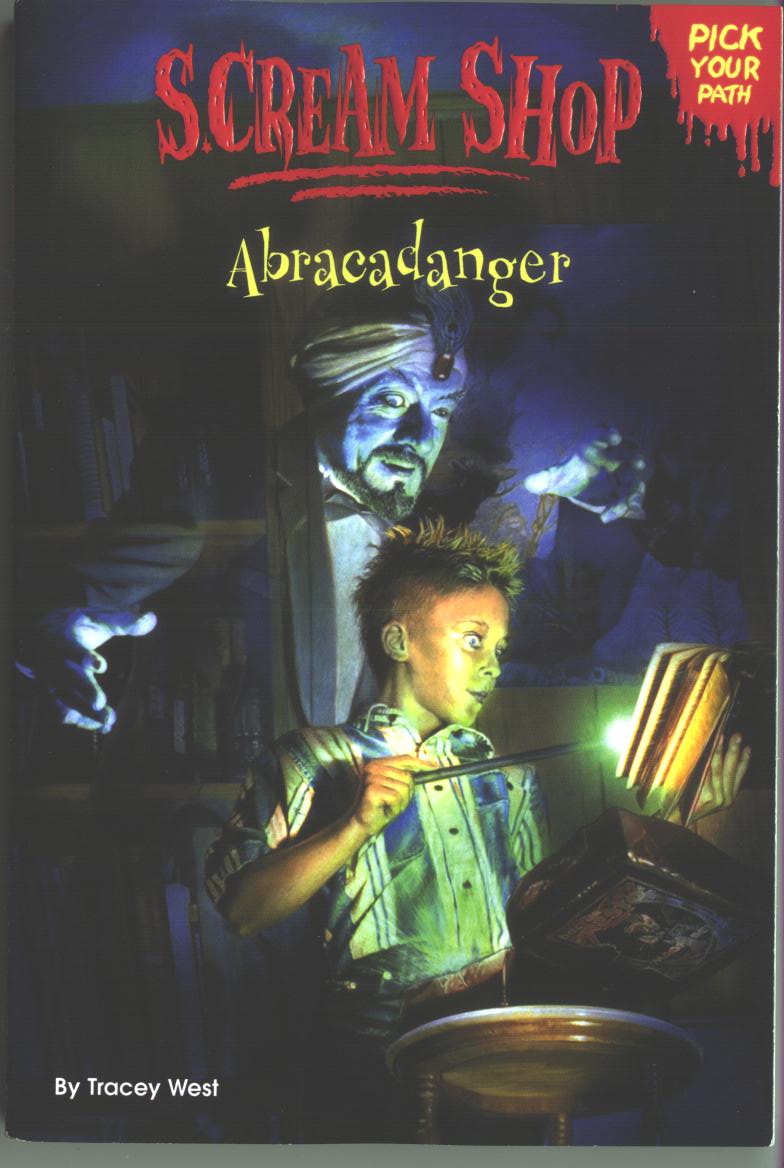
Let’s take a moment to appreciate this hilarious yet effective cover.
Alright, now that that’s over with…you are a little boy with a dream: to become a great magician, famous nationwide. But when you grab an antique magic kit from Sebastian Cream’s creepy old shop, you’re instead neck-deep in multiplying rabbits, alternate dimensions, evil ghosts, and mad science.
It’s like a chaotic set of short Goosebumps stories. Maybe too chaotic for me, and I was never one for goofy horror like this, at any age. But it’s not bad at all. This in no way feels like My Adventure, and some choices are random, but the protagonist also has a name and personality, which makes it go down easier—and despite myself, I did find many sections charming and funny.
The sheer creativity behind many of the magic spells gone awry is also great. I’d rather not spoil much beyond what I mentioned above. Yeah, duh, you get to pull rabbits out of a hat. We expected that. But there’s so much more, and it’s nigh-impossible to predict how to get there. There are also a few grounded routes, for those (like me) who like that sort of thing. You can cut through the nonsense and do your best to become a bona fide magician.
One big weakness Abracadanger has when you put it next to a Goosebumps entry is the simple fact that many of its paths lack depth. Lots of endings have little or no denouement, and some scenes that could have been more impactful are instead very short. That’s common with most gamebooks, of course—obviously when you have multiple paths, you can’t offer the same depth to each that a typical book would give its one ending, or even that a short story anthology can offer.
Still, this is not a bad book.
Damn, they really named him “Sebastian Cream.”
3. The Oregon Trail: The Search for Snake River by Jesse Wiley
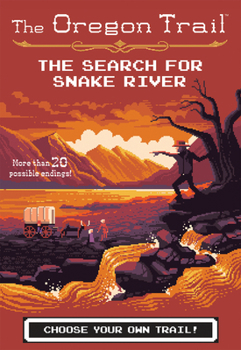
Don’t write this off at first sight, like I did. This is the third entry in a four-book book series based on the classic, ever-marketable computer game The Oregon Trail. The pixel-art cover struck me as…I dunno, I guess I’d say “excessively market-targeting.” Especially because I was certain the book inside would have nothing to do with any video game, let alone that video game. It would probably just be about, y’know, the actual Trail.
And you know what? It basically was. But the adventure inside was compelling. Despite this being part of a longer series, I was perfectly able to jump into the shoes of a boy in a wagon train. Several of your family’s decisions rest on your shoulders. You decide whether to ford a dangerous river (and how) or brave the mountains instead.
While some choices are instant dead ends, a few are longer than I expected. That’s something I personally always like in a gamebook: branching paths that are “wrong” and yet not instant deaths. It just feels more interesting and gives a fuller illusion that you’ve entered a world, rather than merely picked up a book, and that you are somehow a participant.
One thing I was immediately curious about (and pessimistic about) was how this book would depict Indigenous people, if it would depict them at all. Frankly I don’t expect any Oregon Trail-themed story to be respectful, though I wish they all would be. But I think that, given this is a very surface-level treatment of the Trail for children which is ultimately still about the player’s family Manifest Destiny-ing their way across the nation, this depiction might be as good as The Search for Snake River could possibly get. There are Native people with agency, they’re stated to be from the Anishinaabeg nation, and they’re neither hostile nor instant best friends with the white protagonists. I think a conscious effort was made to try to avoid stereotyping.
Another thing I was shocked to end up liking was the “cheat code” section in the back of the book. (At least, that’s what I remember it being called. I gave this book away again months ago, sadly, and wish I’d held off a while.) Before you begin, you’re invited to turn to the very end, post-story, and read some background information about this leg of the Trail and what dangers you might find there. This even includes solutions to many of the dilemmas you’ll face.
Hm…weird.
Well, if you’re like me, you’ve felt that sinking feeling in a game (maybe another CYOA, but the classic example is an obtuse point-and-click adventure) where you simply can’t make an informed decision. The story didn’t tell me how to cure the mystery illness I have; how does it expect me to be able to make the right choice? Well, look in the back of Snake River and you’ll find out what your illness is based on the symptoms, which will tell you how to cure it.
So in that case, it’s a useful anti-frustration mechanic. But still, it’s…legal cheating. Doesn’t that ruin the experience, or at the very least cheapen it? Where’s the challenge when they give you all the answers? And wasn’t there very little challenge at all, since as soon as you lose, you can just go back to the previous page?
I’m actually in favor of this mechanic existing. This isn’t officially sanctioned cheating in a super-strategic historical reenactment. It’s officially sanctioned cheating in a title intended for young readers. A seven-year-old who has no clue what a “dysentery” is going in may get easily frustrated when their character up and dies. If they’re like me when I was seven, they might hit the end of their very first path, think “this book sucks,” and simply close it. Hell, we’re living in the future now. Kids can just find out about dysentery through their phone.
But by including the answers in the back, kids can find out by engaging with the book, meaning that they feel they’re using the book exactly as intended, dealing with Snake River on its own terms, never needing to put it down. That’s clever. Gamebooks are famously cheatable to begin with—if authors themselves can find ways to at least keep the cheating confined to the ecosystems of their own books, more power to them.
This does go against the modern idea of what The Oregon Trail is: hard, hard, really hard, frustrating, and filled with comically abrupt death. (From what I’ve heard, that’s quite unfair to the original vision and how children reacted to the first game when it was newer: check out the programmer discussing how the game was made in this talk.) Playing this is nothing like playing, for example, The Oregon Trail: The Board Game, which you can play a hundred times with skill and never once reach the end of. But it’s much more approachable and just more fun.
4. Dračí srdce: Zrození dračího rytíře (Slovak translation of Drachenherz: Kampf um das Drachenschwert) by Thomas Brezina
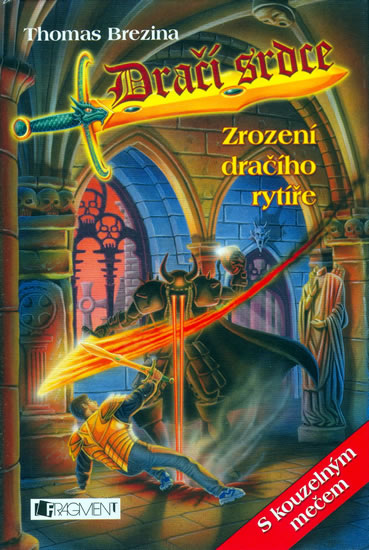
Yeah, that’s right. You all were waiting for this one.
I can’t even read this, so I don’t know how I expect to review it.
Well, um, I can go over its game elements, with the help of my not-very-trusty translation software.
Drachenherz isn’t really a CYOA-style gamebook. From what I can tell, it’s a series of ordinary books with a kind of scoring mechanic. If you can use the hints in each chapter to correctly answer questions throughout the book, you’ll get points. Get enough points and you’ll have…bragging rights! It’s not like this is a video game, so I guess a high score can’t really unlock anything. Still, it’s there.
The way you answer questions is by using a tiny cardboard or plastic “sword” that comes with the book. I got my copy out the Salvation Army (a non-Slovak thrift store chain), so I didn’t have the sword. And no, I can’t grab a picture of the sword provided by the book and photocopy it. Look at this shit:
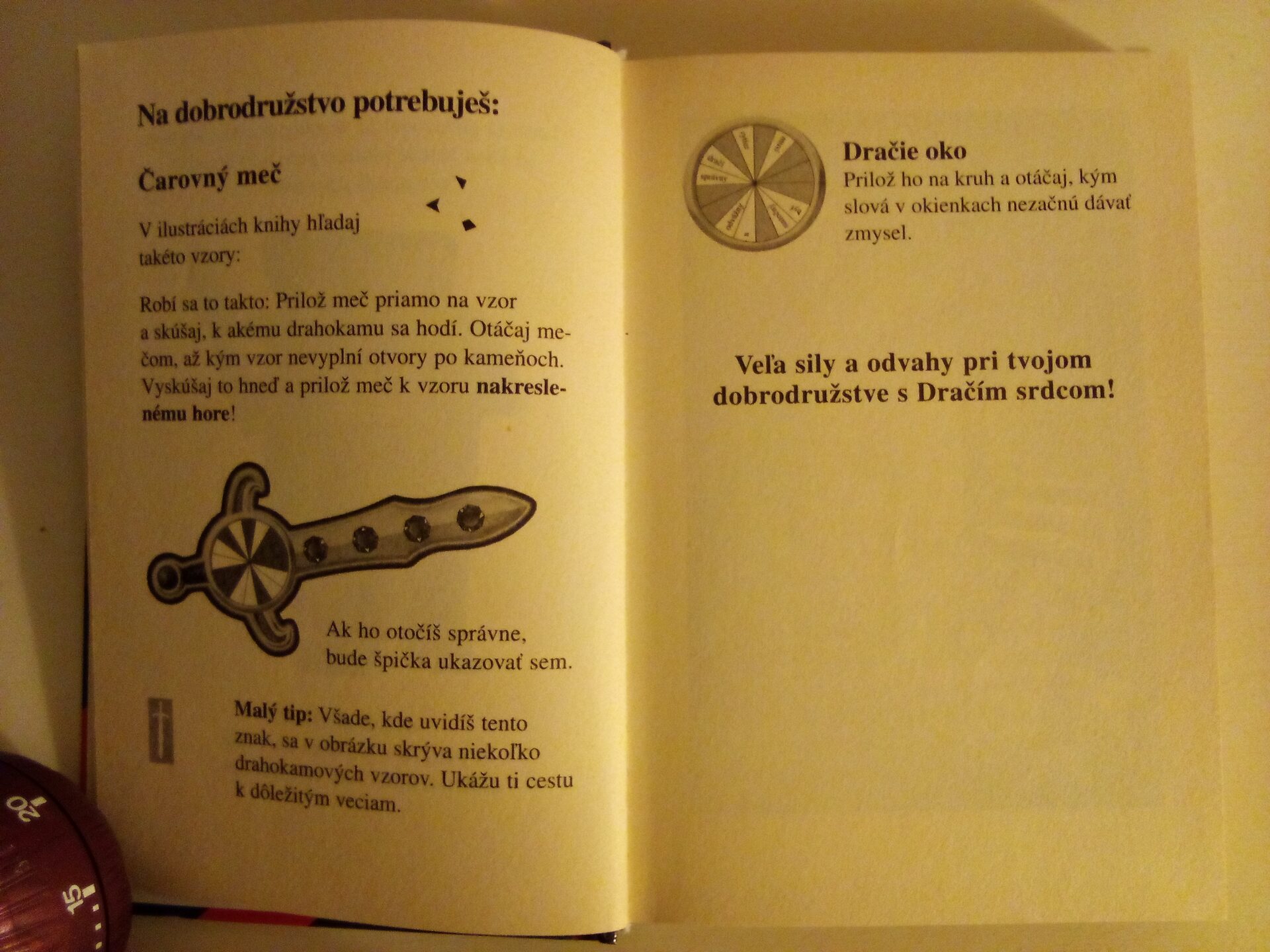
That sword has a wheely thing in the center that you’re supposed to hold over certain circles throughout the book, where it covers up some words and leaves others exposed. Can you imagine meticulously resizing that sword, then cutting those tiny triangles to perfection? If you answered “yes,” you probably have an X-Acto knife. I don’t and I’m proud of you.
The other function of the sword is to reveal things in images. If you hold it and point it a certain way over illustrations, you can answer questions and get the points you crave.
These aren’t my favorite kinds of game mechanics to slot into fiction because they seem easy to ignore. Though I can’t read this without running back and forth to the translator, I assume that after every question that matters to the plot, the story itself will tell you the answer anyway. The scoring section at the end is rudimentary plain text: 20-25 is very good, 0-5 is poor, etc. Not a huge incentive to replay and get better.
But then again, how much can you do? These are books, after all. How can you get them to “thank you” or surrender some privileged information in a way that a reader won’t just cheat or ignore?
Anyway, I feel bad for passing over the storyline of this book, so I’ll tell you what little I can painlessly gather and show you a few illustrations. This book follows your typical boy who can also become a knight in a dragon-filled fantasy land. Beasts will be slain and at least one castle will explode.
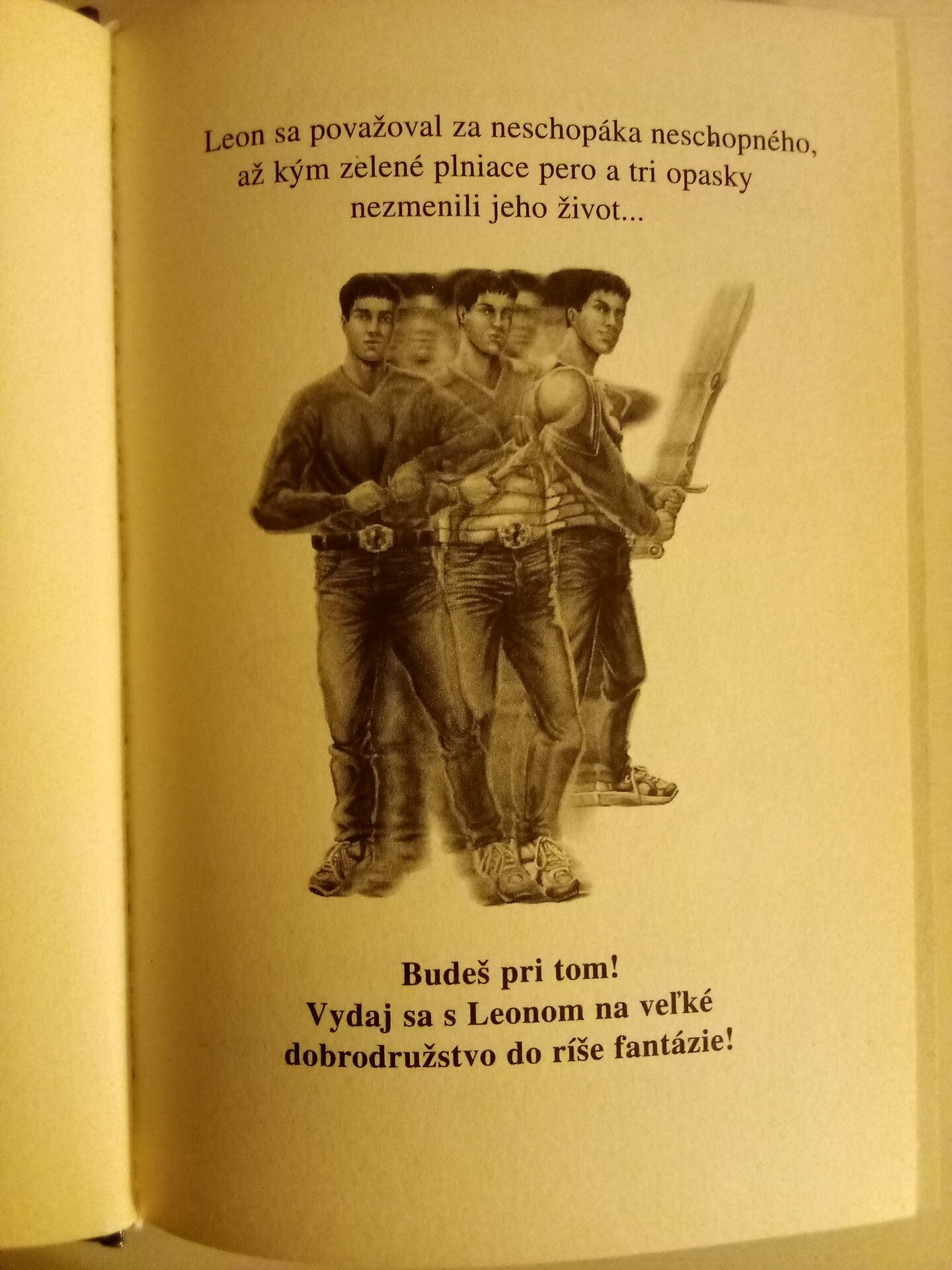
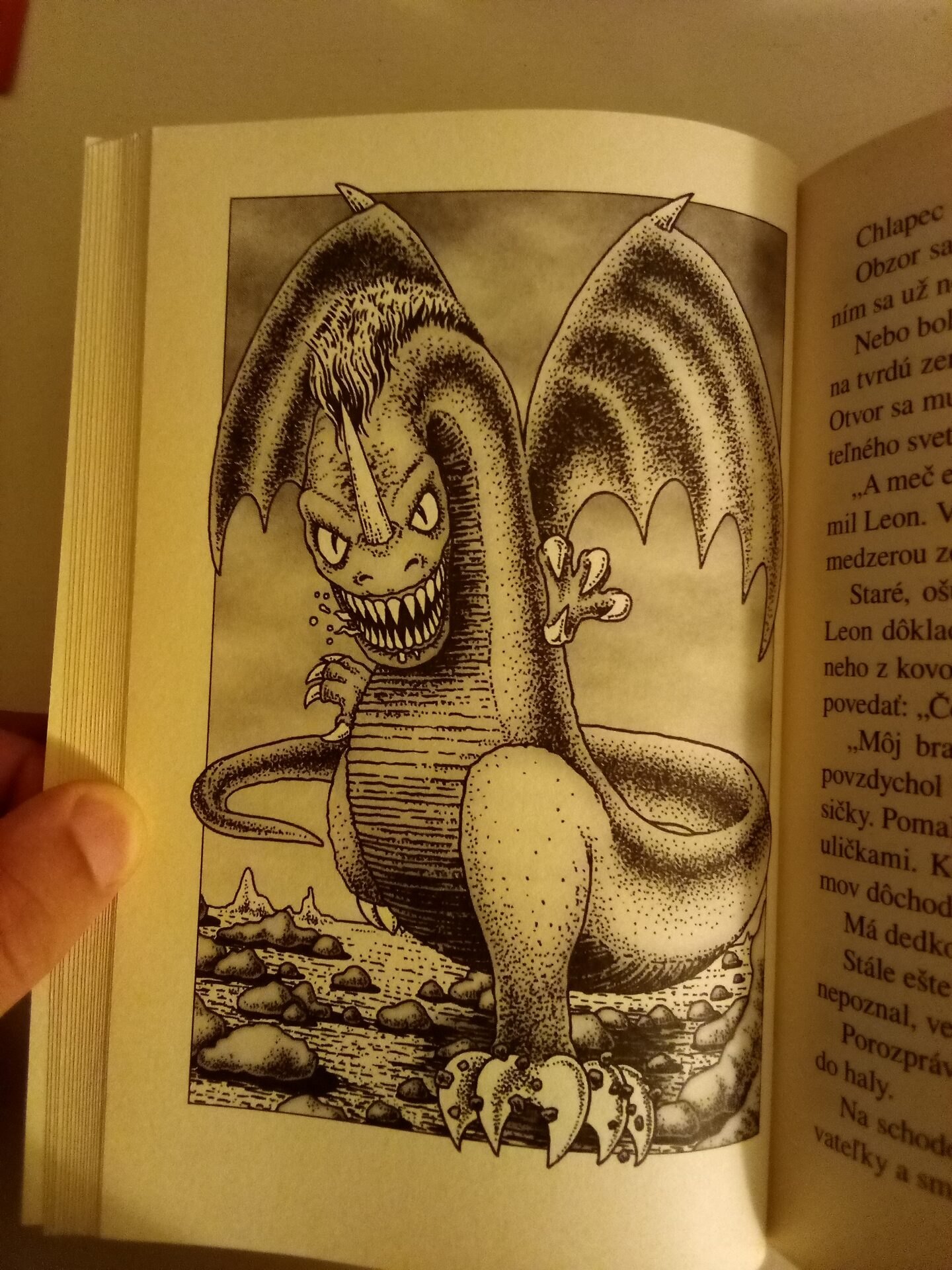

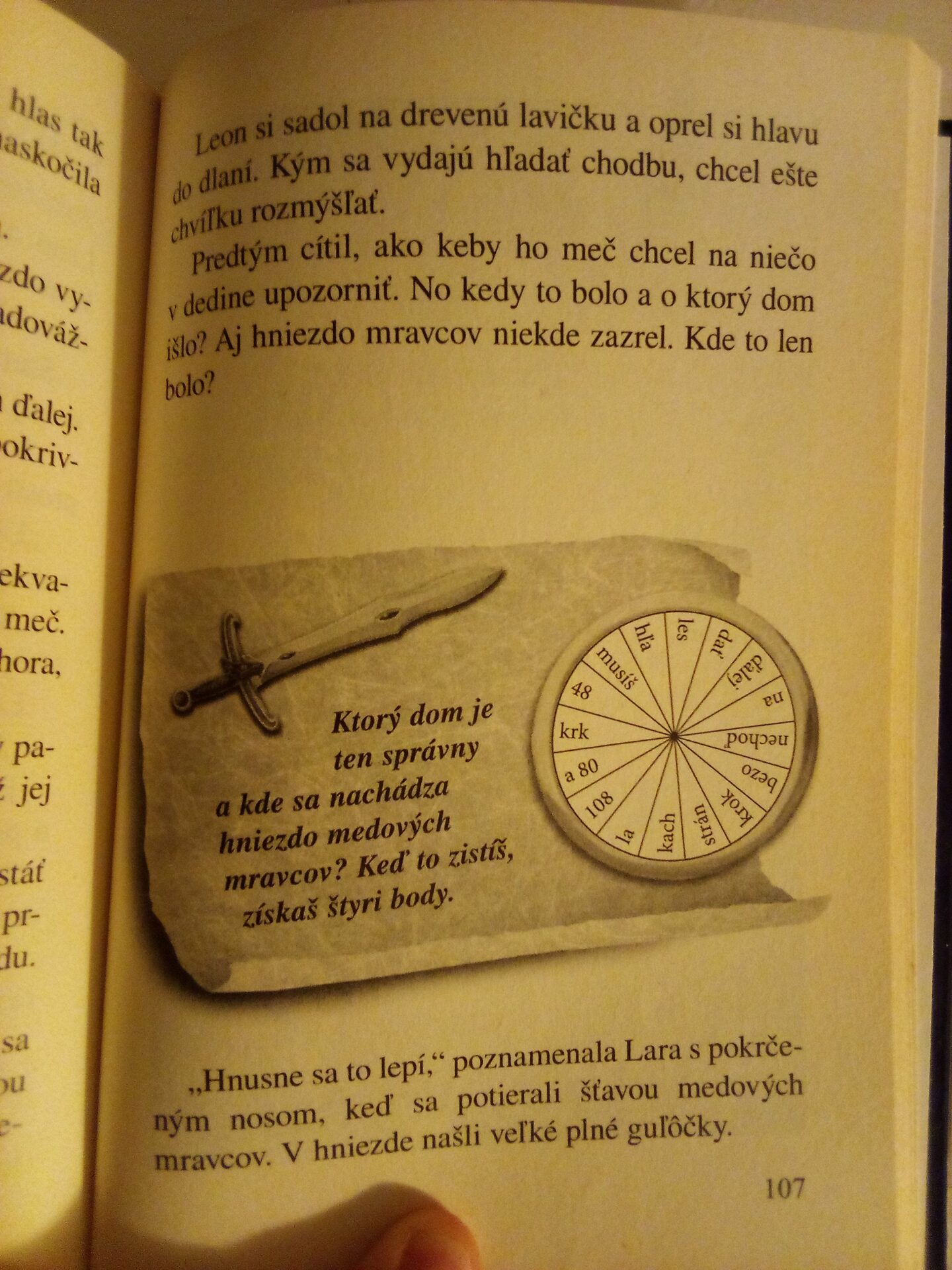
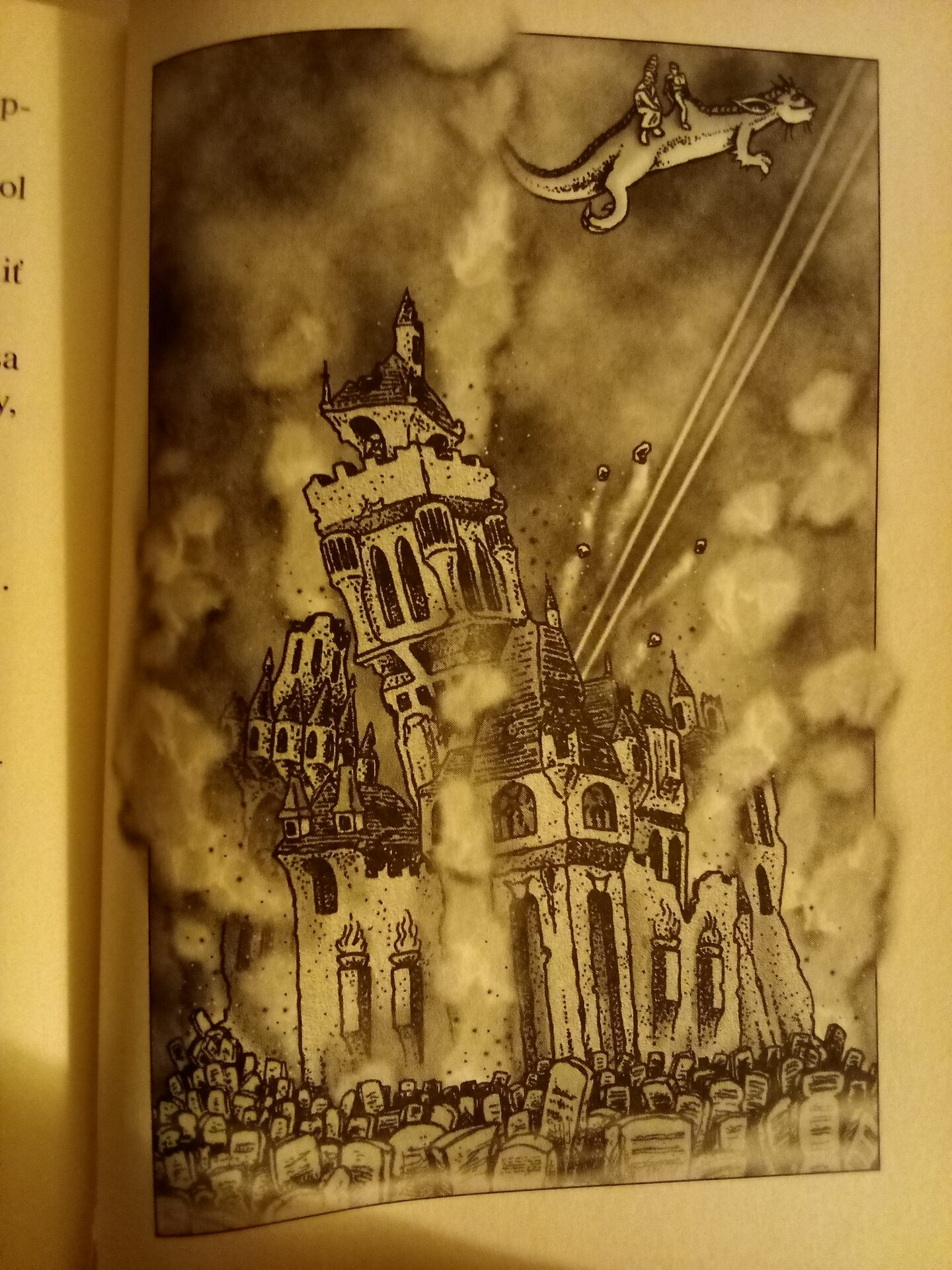
The look of this book strikes me as very European; that boldness helped its spine stick out in a random thrift store in the continental United States. I know there are loads and loads of people who use languages other than English in my area, and yet I was still baffled to find this.
5. Choose Your Own Minecraft Story: The Zombie Adventure by John Diary
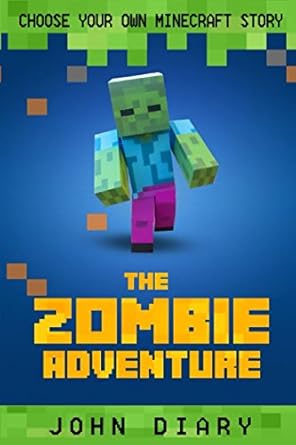
Um…UM…..
Surprise surprise: big huge shocker: this is the first-ever unauthorized parody Minecraft book I’ve read. Still, I know there’s like billions of them sold by indie authors on Amazon, and probably even many on the shelves of Barnes and Noble.
I’m not entirely qualified to review this. I don’t know much of anything about Minecraft. I know it’s got creepers in it. This isn’t about a creeper, though. It’s got crafting in it. This book also doesn’t feature crafting. Instead, it’s about you, a player character, waking up one day as a terrifying monster…and then learning that maybe their messed-up twisted life ain’t so bad.
Uh, I think that the intended demographic and fans of the Minecraft franchise will like this book. Mainly because it has 1,776 reviews on Amazon as of this writing. I didn’t love this book, and especially disliked the more “pointless” and random choices.
But it also has exactly the kinds of humor I loved, and loved to write, when I was a kid and preteen. Things like the branching path where instead of leaving your front door on a zombie quest, you just stay in your room and do nothing. Plus, a few jokes caught even my modern self by surprise and were worth a laugh.

I can’t say I was impressed or excited to read it again for more paths, though. Especially when one long path tossed my zombie in a lake that flowed into a pretty “nothing” cave. Boo!
And I can’t leave without saying that it makes one error that I think is UNCONSCIONABLE: mispelling “noob” as “nube.” But only once. Every other time, it spells it correctly.
It’s quite disturbing.
I can recommend this to fans of Minecraft and people who love the type of humor it’s going for, but the book just wasn’t for me.
6. You Choose: Perseus the Hero by Nadia Higgins, Illustrated by Nadine Takvorian
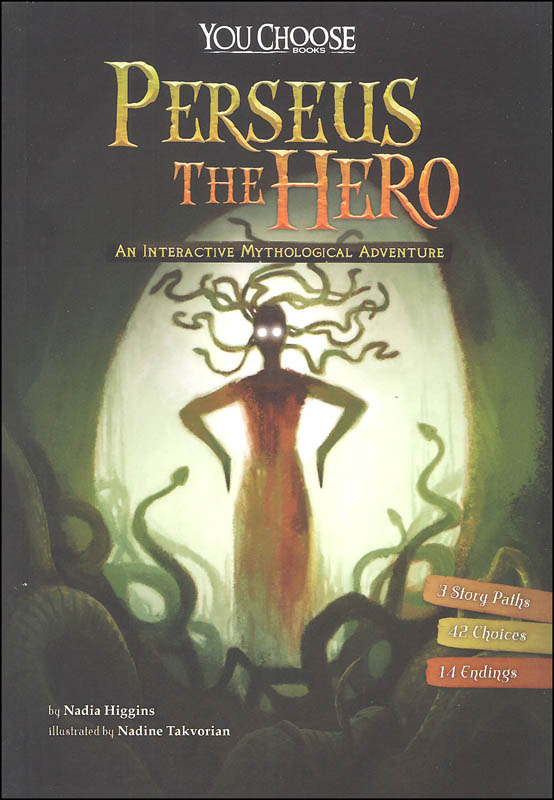
Step into the sandals of Perseus to slay Medusa, ride Pegasus, rescue Andromeda and, uh…accidentally kill your father. It’s all there!!
I have mixed feelings about this book. In the end, I do have to recommend it, especially for the young, far-younger-than-me readers it was intended for in the first place. This is a very accessible introduction to a few flashy Greek myths, and it includes more straightforward educational tidbits in the back of the book. The illustrations are nice, and…frankly, the book just feels nice to read and handle.
It’s also very, very short. The book is beautiful and downright silky. It’s also got 110 pages, including the pictures, the glossary, and some fairly huge text. I’m sure this is because, again, it knows its audience. Younger kids will find this book approachable.
I was fine with all this, and yet I had a sour first impression shortly into my adventure. To start with, your adventure as Perseus is framed as a three-way choice. Will you choose first to slay Medusa, explore the seas, or reclaim your throne? But if you start with anything but slaying Medusa, the book assumes you’ve already done that. In short, these stories really shouldn’t be done in any order, despite them being presented that way.
That alone would have made my child self irrationally angry, but the first impression gets worse. When you go off to the desert to slay Medusa, you’re first met by mysterious helpful Nymphs. They offer to give you a magical gift, and you must choose between two. Unless you know the myth, there’s very little context for which object is better. Do you want flying sandals or a staff that can revive you?
Now, if you choose right, the Nymphs make you another offer of one of two items. If you choose right again, they make a third offer. And if you choose wrong at any point, you die within one to two pages. It’s just not very fun, and from a pure gameplay perspective, it’s a little bewildering to make Perseus’s first grand adventure not defeating a monster, not trekking through harsh wilderness and making a tough decision on the road, but…arbitrarily choosing three of six magical items, all of which sound potentially good. But maybe it was hard to fit the story of Perseus into a game setting with any accuracy. I’m not familiar enough with it to know.
Anyway, like I said, that was mainly a first impression. I mean, it is one-third of the whole book, but the second adventure is genuinely exciting. Paths branch into more than just instant deaths, with more characters, more variety, a little spirit of adventure, choices that begin to matter (“will you marry Andromeda?”) and even a few strange and entertaining deaths (alright, to be fair, the Medusa adventure had a little of that).
But it’s all over very soon. After all, it is a short book, and to be honest, I see it as mostly a teaching tool. Can the third “adventure” even be called that? One of the endings is Perseus staying home and accidentally cutting his dad’s head off. Not exactly wacky. Still, it’s got three endings which kind of make you think about the nature of the Perseus myths and the intended meaning of his tragedy. (Or at least it made me think about that.)
All told, if you know of any young people with any affinity for mythology, gamebooks, or playful illustrated books whatsoever, this would be a pretty good buy. This is part of a longer You Choose series, with each book focused on different Greek myths. Check it out!
7. Solve Them Yourself Picture Mysteries: Timmi Tobbson and the Legend of the Star Runner by J. I. Wagner, Illustrated by C. Fröhlich
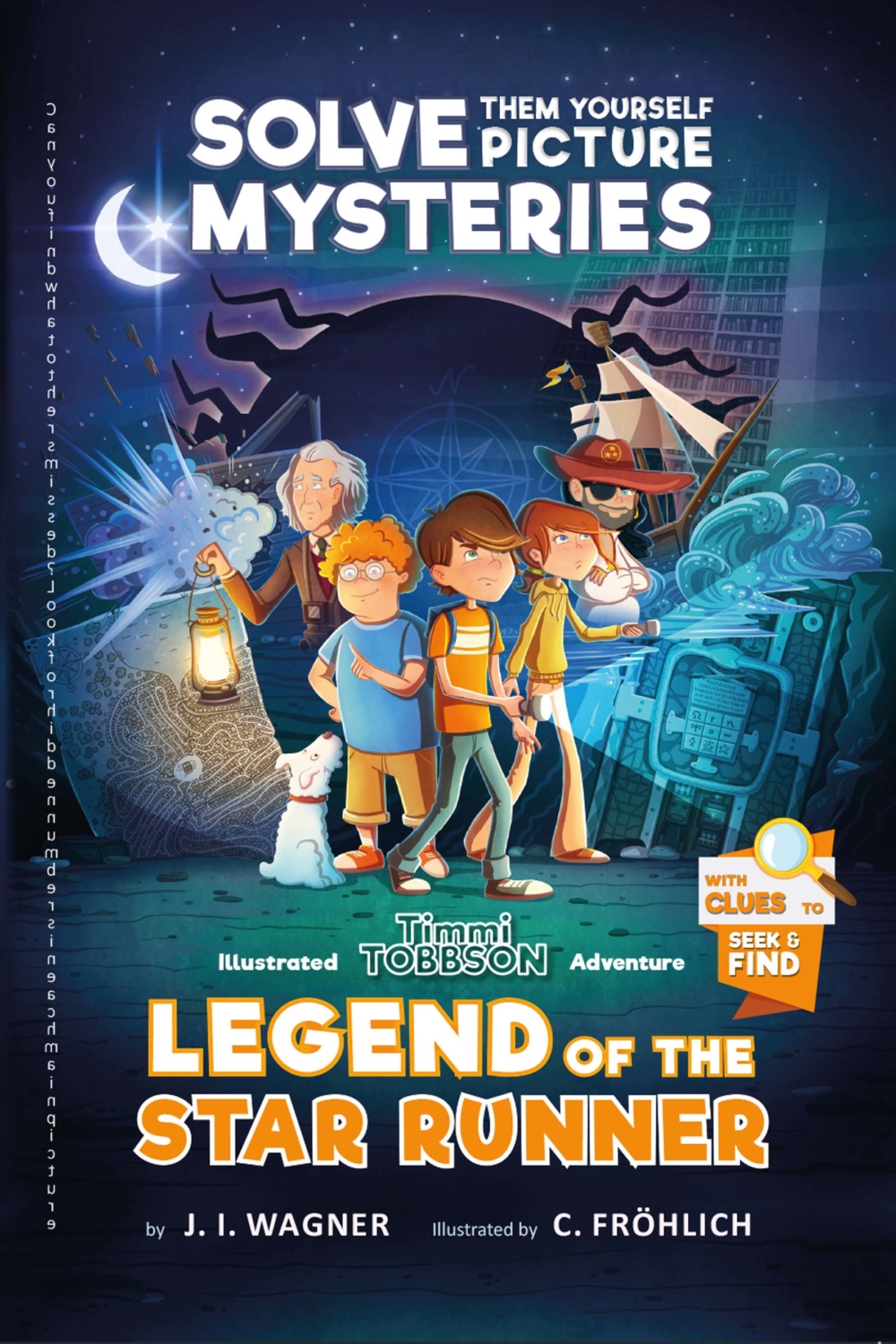
Let’s cap it off with something different, but also something I can kind of read. This isn’t just a children’s mystery book with a tight plot in its own right. It’s also illustrated, and each picture comes with its own mini-mystery.
Legend has it that a pirate ship was pulled into the waters of Timmi Tobbson’s ordinary town—and vanished. What happened to the Star Runner, and where is the treasure of Captain Lotterlulu? And what does this have to do with Timmi’s friend’s grandpa and the colorful, shady characters who seem awfully invested in solving the puzzle themselves?
Before I talk about the game elements, I’d like to discuss the storyline itself. I was pleasantly surprised! As happens with every book that has a “gimmick,” I found myself not expecting much depth from the story. Generally, though, this is a well-done set of big and little puzzles. And while I would change things here and there, my main complaint is about the cast.
See, Timmi is our main character, but he’s got two friends, named Lilli and Marvin. Lilli is a girl and Marvin is fat. Neither one is a caricature, which is always a plus, but even so…you can guess what their personalities are like. Surprisingly, though, my big issue is with Timmi. His personality is…normal. At least Lilli and Marvin got something. Heck, I would’ve greatly preferred either Lilli or Marvin as the main character and removing Timmi entirely. This is pretty painful to admit, but the only trait I picked up from Timmi was that he has asthma. Timmi is perceptive, and he steps up to solve mysteries, but all the kids are perceptive and step up to solve mysteries. On top of that, Lilli gets to be down-to-earth and a little combative, and Marvin gets to basically just be Steven Universe. If all Timmi gets is an inhaler, you may as well fold that into either Lilli or Marvin, right?
Now on to the mysteries. The book contains about thirty chapters, all of them short and ending with a full-page illustration and a question. Can you find the candle in this crowded kitchen scene? Can you figure out which pathway that man must have run down, and use logic to back up your answer? How did Timmi know the code? How did Lilli find out when the librarian would be out of the office?
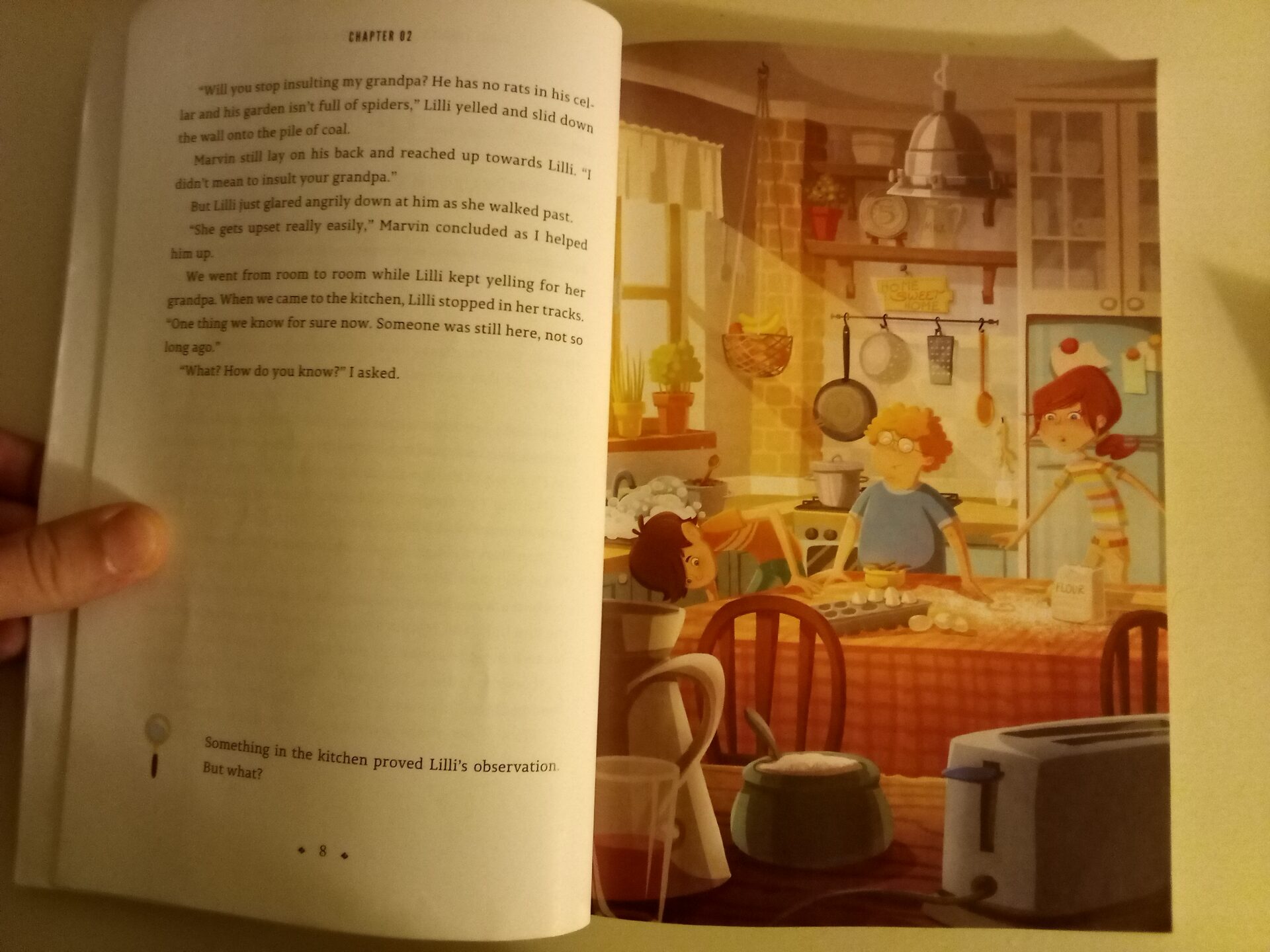
As you’ve gathered, there’s great variety in the questions. They also vary in difficulty—and a question that’s difficult for one person might be a cinch for another. The book itself acknowledges this. Each chapter-ending question includes a difficulty rating, but it’s noted that this is only “how hard the characters think it is.” Maybe a little clunky, but I still appreciate it. It might also be empowering for readers to say, “Wow, that might have been really hard for Timmi, but I solved it in seconds!” Conversely, this explanation softens the blow for when readers say, “My brain hurts. You think this is a one-star mystery, Timmi?!” To stop you from getting too brainsbusted, there are also hints in the back, all shown in reverse to discourage you from reading them all at once.
Many of the questions were easy for me, a currently-twenty-seven-year-old several years beyond the target demographic. I was too lazy to complete one of them beyond guesstimating because I hate math. A handful of them stumped me. Since I’m a bad sport, a couple of those losses made me gripe, “Hey, come on, my answer made sense too! I’m not wrong!!” But others were on me. Some of these puzzles are pretty clever, I gotta hand it to ’em.
Intriguingly, if you go to the Timmi Tobbson website and input a secret code comprised of hidden numbers in all 31 images (note: I couldn’t find one of these numbers no matter how hard I looked, so I brute-forced the digit), you can receive a thank-you poster mailed direct from the publisher! At least, that’s what I think is going to happen. The publisher might actually be European and I’m in the United States. That poster might drown. (Also, more seriously, the poster-mailing might not even be happening anymore. I wouldn’t blame them—they’d be mailing that poster out of their own pocket, to someone who doesn’t even intend to buy more.)
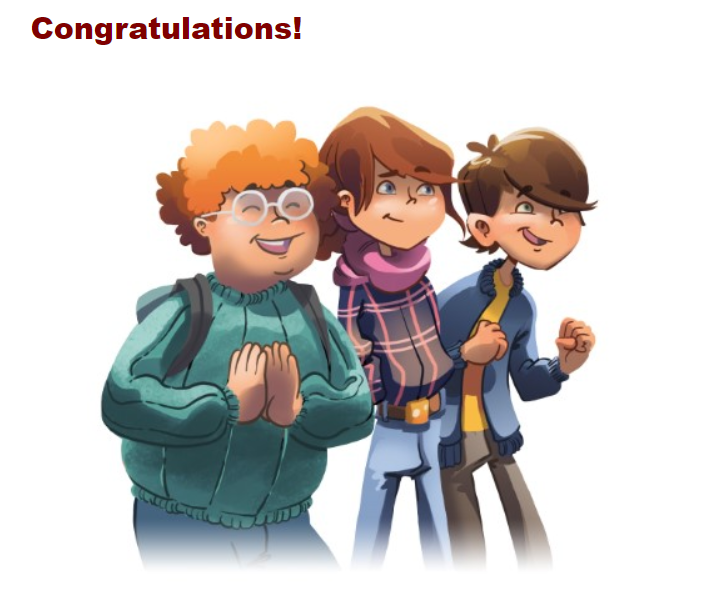
The Timmi Tobbson series contains three books…and apparently also a Junior series that I assume is shorter and has simpler puzzles. A great idea with solid execution. I just hope that in the other books, Timmi gets more personality. That’s literally all they have to do to “fix” this plot in my eyes.
Conclusion: Gamebooks “Я” Great
Writing this article and recompiling all the recent memories I have of reading these nifty titles has stoked my interest in gamebooks yet again. And that always makes me wanna make one! But it’s a huge commitment. These are all works of art, and it took time, energy, and at least a pinch of devotion to make them. Even if they should never have misspelled “noob.”
I wish I saw more gamebooks in the wild, but I’m sure that’ll happen with time. I just have to be patient and keep looking. Or cave and buy stuff online. Or become distracted by several other competing interests (it just keeps happening!).
Post-Credits Scene: Update on My Creative Pursuits
I swore long ago to give biweekly updates on my novel-writing progress via this blog. It’s the only way to stay accountable…maybe. Well, while last biweek I was 35 chapters ahead with my backlog, now I’m…37 chapters ahead! I feel half-sarcastic and half-genuine about that glee. It definitely means that my current plan is working and that my earlier worries about “not being able to make enough for a sustainable backlog” are unfounded.
Besides, I never planned on Catgirl System being some infinite fifty-book story. I’m not going to make Catgirl System the new epic. It’s just not gonna happen.

Thank you for reading, and Patrons, thank you for Patreonning.
I’ve reviewed other things that are gamebook-adjacent. There’s my take on Four Against Darkness, a solo dungeon-crawling adventure where you collect resources, roll dice, and draw your own big map. And there’s also my take on Pokémon Red. A game we’ve never heard of before, I’m sure. Or watch me muse about hobbies!
